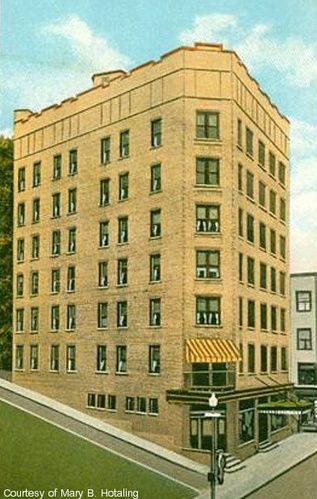 Alpine Hotel Postcard, Mary B. Hotaling personal collection, 2009.
Alpine Hotel Postcard, Mary B. Hotaling personal collection, 2009.
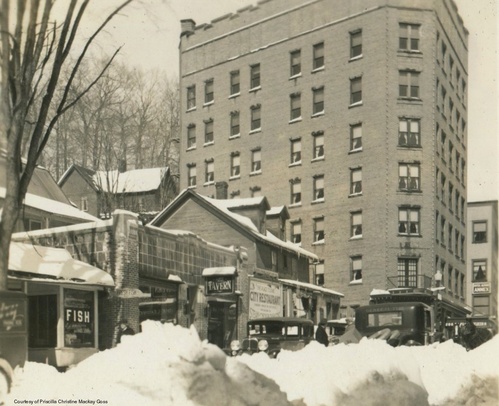 Alpine Hotel, 1930s
Alpine Hotel, 1930s  Arthur S. Knight, Adirondack Guide, Vacationland in Picture Story and History, Adirondack Resorts Press, Lake George, New York, 1947, p. 272. (Library of Congress)
Arthur S. Knight, Adirondack Guide, Vacationland in Picture Story and History, Adirondack Resorts Press, Lake George, New York, 1947, p. 272. (Library of Congress)  James Floyd Ahern in the 1926 Canaras
James Floyd Ahern in the 1926 Canaras 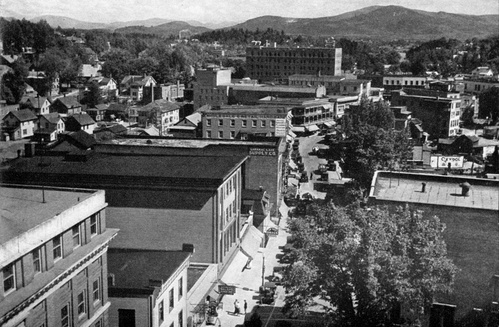 The view up Broadway from the top of the Alpine c. 1948, from a program of the Rebekah Lodge
The view up Broadway from the top of the Alpine c. 1948, from a program of the Rebekah Lodge 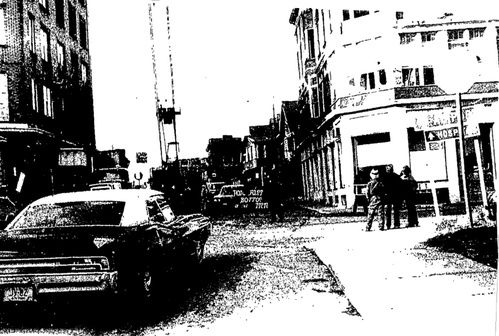 DEMOLITION — Work began this week on razing the 50-year-old Alpine Hotel and lounge. Workers of Dumoulin Excavating are constructing a traffic barrier while an ex-employee of the lounge takes a sign as a memento. Patrolman Neil Rogers directs traffic. (Odato photo) Adirondack Daily Enterprise, November 16, 1977
DEMOLITION — Work began this week on razing the 50-year-old Alpine Hotel and lounge. Workers of Dumoulin Excavating are constructing a traffic barrier while an ex-employee of the lounge takes a sign as a memento. Patrolman Neil Rogers directs traffic. (Odato photo) Adirondack Daily Enterprise, November 16, 1977  Winter Carnival mosaic on the foundation walls of the old Alpine
Winter Carnival mosaic on the foundation walls of the old Alpine 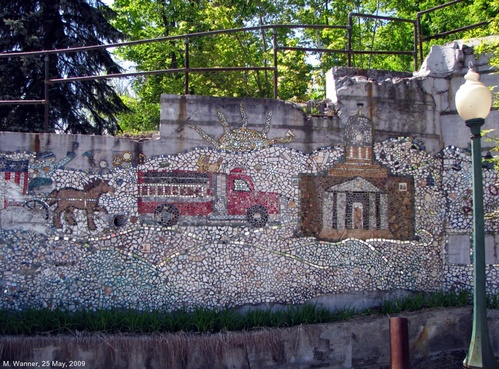 A mosaic on the foundation walls of the old Alpine HoteAddress: torn down in 1977
A mosaic on the foundation walls of the old Alpine HoteAddress: torn down in 1977
Old Address: 84 Broadway
Year built: 1926
The seven-story, steel-framed brick Alpine Hotel, located at 84 Broadway, was once the tallest building between Albany and Montreal. It was used as the first dormitory for Paul Smiths College. It was triangular in plan, and was thus nicknamed the Flatiron building, after the Manhattan building of the same name. It was demolished in 1977.
Sources • Riley, Howard, ''Adirondack Enterprise'', December 27, 2008 • Tissot, Caperton, History between the lines : women's lives and Saranac Lake customs, Jay, New York : Graphics North, 2007. ISBN 978-0-9643542-9-4
Adirondack Daily Enterprise, September 8, 1977
'Rosalind Russell Slept Here'
If a sign saying "Rosalind Russell Slept Here" were hung on the Hotel Alpine, the structure might survive. But right now, the Saranac Lake hostelry appears headed for a short run.
Franklin County has taken steps to have it closed for non-payment of taxes. And the hotel also owes tax money to the Village of Saranac Lake.
When Rosalind Russell stayed at the Alpine, it was still new. A double row of outside lights ran up the seven floors of the wedge shaped building like it was as much part of showbiz as the actress herself
Miss Russell had joined the Adirondack Players in the late 1920s. She was destined for greatness. But just then she was only learning the trade as a member of the cast of Saranac Lake's tent theater group.
In retrospect, she was the most famous personage ever to have stayed at the Alpine. When the hotel was being constructed in 1926, you could hear the pumps running day and night to overcome underground water problems that were plaguing work on the foundations.
But the yellow brick "Ricketson Building" as it was sometimes called, kept rising majestically skyward. It was designed in the same mold as New York City's famous Flat-iron Building.
SINCE THE lot on Broadway was comparatively small for a hotel and the terrain steep at the rear, it counted on elevation, rather than extensive floor space, to make its mark in the booming hotel business in Saranac Lake.
Either through complaints by local authorities or rulings by the state departments overseeing the public's health, safety and welfare, the top three interior floors were never finished. The studding and basic layout of the bedrooms and bath rooms however, were incorporated in the original blueprint.
The Alpine builder, H.C. Ricketson of Plattsburgh, was determined to overcome all obstacles to get his hotel into commercial productivity. Saranac Lake's 1926 Village Board had received complaints at every level of completion. Opinion along Main St. was that the building was unsafe and that it should not be allowed to go higher until its construction was proved sound.
Mr. Ricketson felt that the architect had done a competent job and was prepared to pay the extra expense to hire a neutral and disinterested firm to prove it. Charles Kiehn of Utica, a reputable engineer, was asked by Mr. Ricketson to inspect the Alpine and report his findings for presentation to the Saranac Lake Village Board.
MR. RICKETSON'S immediate plan was to finish 50 rooms to keep pace with the successful St. Regis diagonally across Broadway which had 65 rooms in its five floors. The Plattsburgh builder reasoned that with seven floors he could expand if business warranted it.
On completion, the main floor included the lobby, dining room, kitchen and offices with an elevator shaft that extended from the basement to the top floor. It had been claimed by opponents of the building that there wasn't enough steel in the framework to support seven floors. The completed report by the Utica engineer, however, disputed that premise. The Kiehn report said:
"My examination of the loads on the structural steel work has been thorough and in this I have considered all the possible loadings that may be put on the various floors. From the examination made. I found that the steel work within the walls and the piers has shown that the building is structurally safe, further that beams and columns will not be loaded beyond the safety factor, that is, the steel work has been properly designed to carry the loads placed upon the members.
"As to this building being able to do the work required of it, I will say that the structure is properly designed and structurally safe."
A sprinkler system with 560 heads had been included in the architect's plan to meet fire protection requirements. The report apparently satisfied the Village Board and the hotel finally opened for business.
THE ALPINE failed to generate the volume of business anticipated. Almost from the start, the hotel was plagued with problems stemming from the widely-circulated stories that it was unsafe. The public doggedly insisted that the top three stories would have been completed if the building could have supported the weight. The only people ever to use the top floors were students of the Saranac Lake Study and Craft Guild.
Rosalind Russell, who was only 18 and had little money, found the Alpine prices and meals reasonable and appeared in the tent theater behind the bank in Little Accident, Salt Water, Nancy's Private Affair and The Bachelor Father. Her final appearance was Nanette in Getting Gertie's Garter.
When prohibition was repealed in 1933, the Alpine was given a shot in the arm. It became a night spot of considerable popularity in the downtown section although competition was heavy among the cafes and bars of the community during its years as a health resort.
The Alpine gradually became a haven for traveling salesmen and seasonal worker's who wanted downtown rooms with good meals at a fair price. The Alpine Annex next door was for a time headquarters for the New York State Police.
Over the past several years, the decline in hotel business the cost of heating and spiraling taxes constituted a burden that helped nail the lid on the Alpine coffin. While the hotel continued to function, foreclosure was always an imminent threat.
THERE WERE several people living in the hotel when the eviction notice was served recently. A potential buyer had made the down payment in 1976 but eventually backed out forfeiting the money he had put down.
The county and the Village Boards have not been in total agreement as to the fate of the building once the doors are closed. The cost of demolishing the hotel would run about $22,000. And there is still some question that the lot which is awkward, fairly small and backed by the steep Alpine Terrace would be readily saleable as a real estate holding.
Many in the village are already alarmed at the rate the older buildings are being torn down, especially those classed as landmark structures. The passing of three hotels on one corner— the St. Regis, Potter Block and the Alpine combined with the razing of the Mullen Block directed attention to the Berkeley. Strong feelings on the matter may cause sparks to fly as plans to revitalize the village are implemented under a master plan.
One faction sees the St. Regis Corner as a prime commercial development site with the old buildings gone. Others say it will merely add another parking lot for people who have no reason to park since there will be nothing left but parking space anyway.
Whatever the outcome, a decision will be announced shortly on the fate of the Alpine, whose tombstone may read "RIP, 1926-1977."
Adirondack Daily Enterprise, June 13, 1962
VILLAGE OWED $5800 IN TAXES BY HOTEL IN S.L.
Hotel Alpine May Default
Ralph Mazolla of the Hotel Alpine appeared at the regular meeting of the Saranac Lake Village Board last night to discuss the hotel's 'tax problem'.
The amount of $5800 is due in taxes on the Alpine property and must be paid by September 1 or ownership will revert to the village. Mr. Mazolla asked if he Board would accept $1850 as a payment which is the amount of the oldest tax due with penalties and subsequent payments of ihe same amount in the years to follow, until the tax is paid.
The Board explained that they cannot legally accept a partial payment of back taxes and although they did not want to sea the Alpine go out of business they could not arrange installment payments on the taxes. If the taxes are not paid by September, the village will assume ownership and then may sell the hotel back to the present owner for any set amount.
 Alpine Guest Registration Card
Alpine Guest Registration Card
Courtesy of a reader
Adirondack Daily Enterprise, February 6, 1964
Hotel Alpine Sold by Village for $17,000; Former Owner Isabella Tops Ratigans' $3500
The Saranac Lake Village Board has accepted a bid of $17,000 for the Hotel Alpine. The bid is subject to approval by Franklin County.
Meeting in special session yesterday evening, the board opened two sealed bids for the hotel which was repossessed for nonpayment of taxes.
The high bid of $17,000 was made by Ralph J. Isabella, former owner of the hotel before it was closed two months ago.
A second bid of $3,500, no strings attached, was made by the Gore Mountain Realty Company of North Creek. Officers of the Company are Mr. and Mrs. John (Frank) Ratigan.
Before it was repossessed for non-payment of taxes, the hotel was owned by Alpine-Saranac Inc., of which Mr. Isabella was president.
Under the terms of the bid, Mr. Isabella gave the village a certified check for $1700 yesterday. After three days, he will give the village an additional 50 percent and on or before April 25, 1964, he will pay the village the remaining 40 percent.
He will be given three days for his attorney to check all titles.
Mr. Isabella said he would accept responsibility for settling all existing mortgages. There has been much discussion of a mortgage on the elevator, fire escape and other equipment, but Mr. Isabella said that if there was any legal settlement to be made on this mortgage, his lawyers would take care of it.
There was approximately $18,500 in back taxes owing on the hotel. While the hotel has been closed, it has cost the village about $2000 to maintain it and almost $600 in taxes have been lost during that period.
Mr. Isabella intends to reopen the hotel and manage it as he did before. When he left Saranac Lake two months ago, he took over the Holiday House in Tupper Lake. He told The Enterprise there would be no change in the management or operation of the Holiday House.
The village, after taking possession of the hotel in the first week of December, started to advertise for buyers. Only two inquiries came from outside the immediate area.
At one point, Charles Vosburgh put forth the idea of his selling it at auction for the village but the board chose to take sealed bids which they opened yesterday.
There had been conjecture that the value of the Alpine property would increase when the Hotel St. Regis burned down, and the owner of the St. Regis attended several meetings when the disposition of the Alpine was being discussed. It is not known how far his interest in the other hotel went, even after his own was destroyed by the fire.
The Hotel Alpine was built in the 1920's and two floors have still not been completed.
The taxes on the building are about $3,600 a year and according to Mr. Isabella, it takes approximately $90 a week just to heat the building during the winter.
Francis Casier, a former owner of the hotel and a present mortgage holder, said that one of the problems with the Alpine was that it was inequitably taxed.
Mortgages on the property are held by Mr. Casier and the Farmer's National Bank of Malone.
Proceeds from the sale will be split between the county and the village.
Adirondack Enterprise, November 15, 1926
NEW RICKETSON HOTEL BUILDING DECLARED SAFE
Report of Utica Architect Submitted to Village Board to Refute Recent Claim Structure Not to Be Strong Enough
The new hotel building at 82-84 Broadway being constructed by H. C. Ricketson of Pittsburgh is properly designed and structurally safe. In the opinion of Charles Kiehm, an architect and engineer of Utica, who recently inspected the building for the owner.
Mr. Kiehm's report has been submitted to the Saranac Lake village board of trustees, who some time ago raised the suggestion of the safety of the structure and of its conformity to building regulations of local ordinances.
The building is seven stories in height, the main floor being designed for lobby, offices, dining room and kitchen, and six upper floors for guest rooms. Mr. Ricketson plans to finish between 40 and 60 rooms immediately.
Work has now reached the point of finishing the interior. Marbloid floors, steel stairs, and hard finished plastered walls are specified by the owner, and there is also to be a sprinkler system with 560 heads.
Mr. Kiehm wrote the following letter in connections with his report;
Mr. H. C. Ricketson, Plattsburgh, N. Y. Dear Sir:
Under separate cover I am sending two copies of report on your building at Saranac Lake.
This report covers the general construction work and does not include the heating, plumbing, or sprinkler system. As to these portions of the work, you did not show me any layout of the various systems; therefore could not make a report on this work.
The investigation made included an examination of the plans and also an inspection of the building as to its construction, which included investigating the strength of the steel beams, columns and the loads, on the girders and the walls and piers of the structure.
On the construction work, I would report the mason and carpenter work has been well done and that the walls and floor systems are well built.
My examination of the loads on the structural steel work has been thorough and in this I have considered all the possible loadings that may be put on the various floors, from the examination made I find that the steel work within the walls and the piers has shown that the building is structurally safe, further that beams and columns will not be loaded beyond this factor of safety; that is, the steel work has been properly designed to carry the loads placed upon the members.
As to this building being able to do the work required of it I will say that the structure is properly designed and structurally safe.
With kindest regards and wishing you success with your new building, I am.
Respectfully yours,
Charles Kiehm
From: Phil Gallos, "Throw-away Buildings. A Saranac Lake Notebook," from the Newsletter of the Center for Adirondack Studies, North Country Community College, c. 1980.
The intersection of Bloomingdale Avenue and Broadway once boasted three of the largest and proudest buildings in Saranac Lake: the four-story Adirondack Hotel (commonly known as Potter Block) , the five-story Hotel St. Regis, and the Hotel Alpine. . . .
Although the Alpine and Potter Block were both habitually labeled "fire traps," the bureaucrats (who were doing most of the labeling) got to them before fire had a chance.
Both structures had sprinkler systems -- good ones. The men who demolished the Alpine were quite impressed with the building. Those I spoke with didn't believe it was a fire trap. As for the Potter Block, one Saranac Lake fireman said this: "Potter Block had the best sprinkler system in town. We had lots of small fires in there, but they never got anywhere."
Then after a moment's thought, he added, "Of course the best sprinkler system in the world doesn't do you much good if it's shut off."
The Alpine was jointly owned by Franklin County and the Village of Saranac Lake, having been acquired for unpaid taxes. It housed a thriving business, and people lived there.
. . .
So the Potter Block and the Alpine were lost. For a month in Autumn '77 and a month in Spring '78, people stood around with horrified expressions and watched the engines of destruction reduce practically every part of the two buildings to useless rubble. About the only things the demolition crews saved were the great, six-by-twelve inch hardwood beams from the Potter Block and the steel from the lower floors of the Alpine--steel which, according to a number of the building's critics, wasn't there.
. . .
It cost roughly $35,000 to smash up the Alpine. With that amount of money, four men could have been employed at a decent wage for a year to take the building apart the same way 50 Church Street was taken apart--by hand, so the materials could be recycled.
I often wonder how many houses could have been built with the materials from the Alpine and Potter Block. . . . All those bricks and timbers and fixtures, all those doors and windows and beams and pipes, all those sinks and lamps and windows were trucked away as fill for a parking lot on Ampersand Avenue.
Adirondack Daily Enterprise
May 25, 2002
"Establishing signs of the times" by the late Bill McLaughlin (Reprinted from November 1976)
The Front Page
" . . . Chester Fobare, of the current village board, found ammunition [in the facsimile edition of the Enterprise's first issue as a daily paper] to support his claim that the Hotel Alpine was always a white elephant. He would like to see it leveled.
"The story over the years was that they never finished off the top two stories because there wasn't enough steel in the building to support the added weight. Ray Ridabock held art classes on the top floor in the years after World War II, and the studio area was a maze of studding and warped floors."
Comments
2011-12-24 19:09:02 this is a great find for me.I am trying to find all the history on this.I am married to family member that had owned this hotel. —johnmorock



